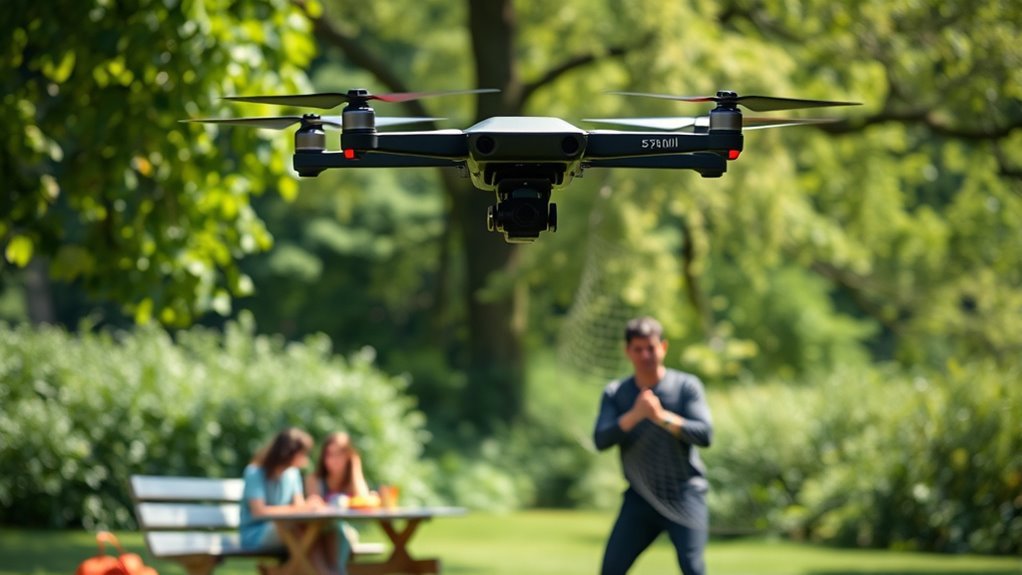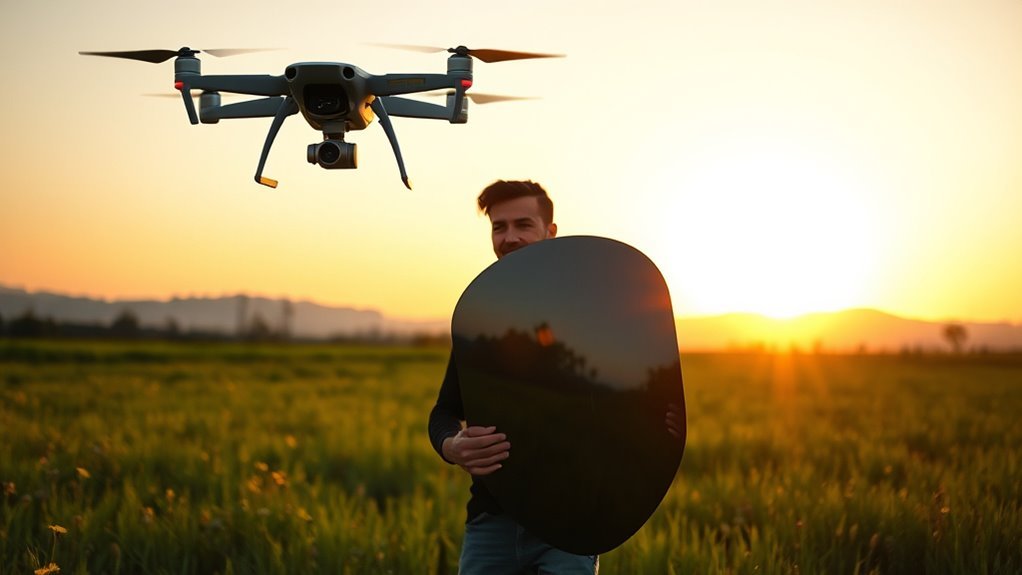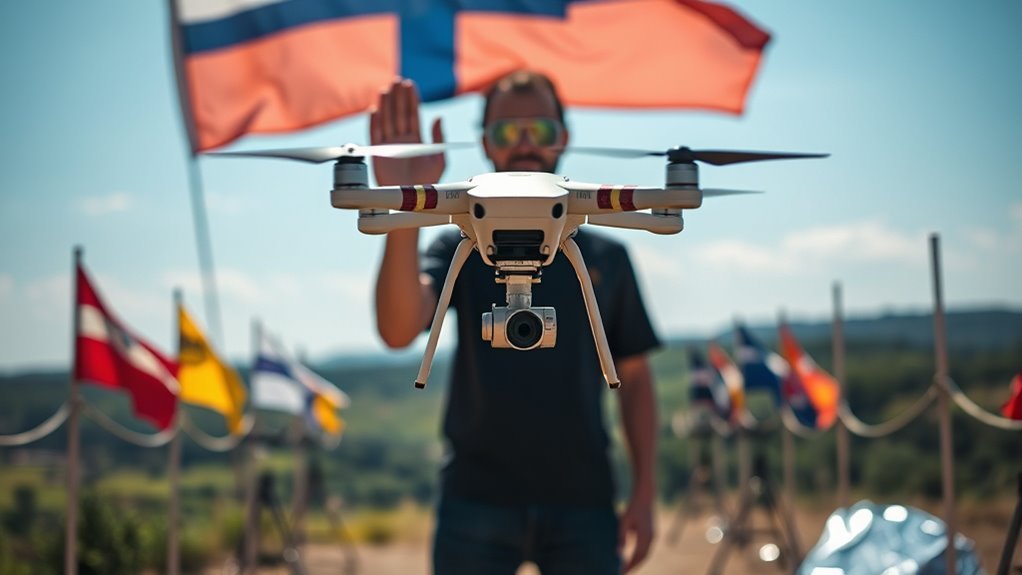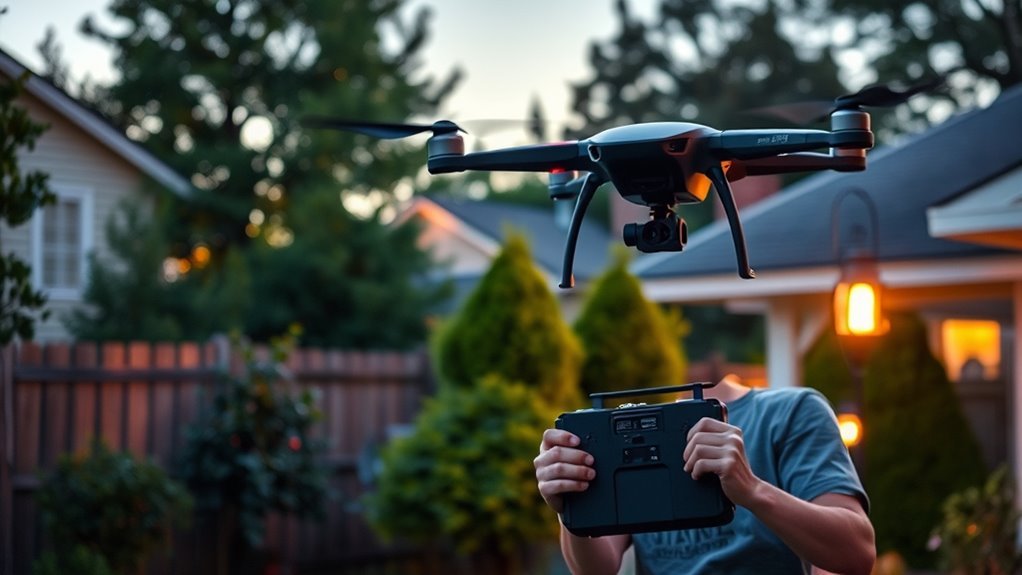To stop a drone and guarantee your personal safety, start by understanding how drones function and the legalities surrounding their use. Create physical barriers like fencing or tree plantings to establish a no-fly zone. Consider signal jamming options, though be aware of local laws. Engaging in community initiatives can enhance vigilance and cooperation. It’s also vital to know how to report unwanted drones effectively. There’s much to explore about these strategies and more ways to protect your space.
Understanding Drone Technology: How Drones Work

Drones, often referred to as unmanned aerial vehicles (UAVs), rely on a combination of hardware and software to function effectively. Understanding drone components is essential for grasping how they operate. Key elements include the airframe, motors, propellers, and onboard sensors, which work together to achieve stable flight. Flight mechanics play a significant role in this process; the principles of lift, thrust, drag, and weight govern how a drone maneuvers through the air. When you comprehend these fundamentals, you gain insight into a drone’s capabilities and limitations. This knowledge empowers you, enabling informed decisions about personal safety in scenarios involving drones. Recognizing their technological intricacies can help you develop strategies to address potential threats to your freedom and privacy. Additionally, understanding aspects like flight time and battery performance can further enhance your awareness of how drones operate in various conditions. Furthermore, factors such as battery capacity and environmental conditions can significantly influence a drone’s operational range and effectiveness.
Legal Considerations for Stopping Drones

When considering methods to stop a drone, it’s essential to understand the legal framework governing drone usage and self-defense. You’ll need to familiarize yourself with specific regulations that dictate what actions are permissible when confronting an intrusive drone. Additionally, self-defense laws can vary considerably, impacting your ability to respond effectively without facing legal repercussions.
Drone Regulations Overview
As the use of drones continues to expand across various sectors, understanding the legal landscape surrounding their operation becomes increasingly essential for personal safety. Familiarizing yourself with drone regulations can help safeguard your drone privacy and enhance overall drone safety. Here are key points to take into account:
- Federal Regulations: The FAA has established guidelines that govern drone flight, including altitude limits and no-fly zones.
- State Laws: Many states have specific laws addressing drone usage, especially regarding privacy violations and trespassing.
- Local Ordinances: Municipalities may impose additional restrictions, so it’s important to be aware of local regulations.
Self-Defense Laws Explained
Understanding self-defense laws is essential for anyone contemplating actions to stop a drone, especially since the legality of such actions can vary considerably. You need to be aware of self-defense techniques that could be applicable, but it’s vital to evaluate the legal ramifications. Here’s a quick overview:
| Action Taken | Potential Outcome | Legal Standing |
|---|---|---|
| Physical interference | Possible property damage | Likely illegal |
| Reporting to authorities | Drone may be removed | Legal and advisable |
| Using technology | Disruption of service | Potentially legal |
| Non-violent measures | Minimal risk of escalation | Generally legal |
Knowing these factors can help you navigate the complexities of responding to drones while protecting your rights.
Physical Barriers: Creating a No-Fly Zone

While technology has made drones more accessible, it’s essential to establish physical barriers that create a no-fly zone for these devices. Implementing effective no fly enforcement measures can protect your personal space and guarantee your freedom.
Consider these physical deterrents:
- Fencing: Install tall, secure fencing to deter drones from entering your property.
- Netting: Use drone netting that captures and prevents unauthorized aerial entries.
- Natural Barriers: Strategically plant trees or shrubs to obstruct drone paths.
Signal Jamming: Disrupting Drone Communication
Physical barriers can effectively limit a drone’s access to your property, but sometimes, additional measures are necessary to confirm personal safety. Signal jamming is one such method that can create significant communication disruption between a drone and its operator. By generating signal interference, you can prevent the drone from receiving commands, effectively rendering it inoperable. However, it’s essential to recognize that using jammers may be illegal in many jurisdictions, so you should familiarize yourself with local laws before proceeding. If legal, this technique can provide a powerful layer of security, allowing you to reclaim your privacy and autonomy. Always stay informed about the technology and regulations surrounding drone usage to confirm your personal safety without infringing on others’ rights.
Anti-Drone Weapons: A Look at Available Options
Several anti-drone weapons are available on the market today, each designed to neutralize unauthorized drones effectively. These options can help you maintain your privacy and security in an increasingly surveilled world.
- Anti Drone Lasers: These systems use concentrated beams of light to disrupt drone operations, targeting their sensors and causing them to malfunction.
- Drone Nets: These devices deploy nets to physically capture drones, allowing for safe retrieval without damaging the aircraft or surrounding property.
- Electromagnetic Pulse Devices: These can disable a drone’s electronics, rendering it inoperable without physical harm. Additionally, using precise targeting techniques can enhance the effectiveness of laser systems in mitigating drone threats.
Using Technology: Drone Detection and Tracking Apps
As the threat posed by unauthorized drones grows, utilizing technology for detection and tracking has become increasingly important. You can leverage drone detection technology and tracking apps to enhance your personal safety. These tools work by identifying drone signals and providing real-time information about their locations. By using these apps, you can stay informed about any nearby drones and assess potential risks. Many applications also allow you to report unauthorized drone activity, which helps create a safer environment. In addition, some advanced options offer integration with alert systems, enabling you to receive notifications directly. Embracing this technology not only empowers you but also reinforces your commitment to safeguarding your freedoms in an increasingly monitored world.
Community Initiatives: Working Together for Safety
Community initiatives like neighborhood watch programs and awareness campaigns can greatly enhance safety against drone risks. By collaborating with your neighbors, you can create a collective response that not only monitors drone activity but also educates residents about potential threats. Such proactive measures foster a sense of security and shared responsibility within your community.
Neighborhood Watch Programs
While it might seem that personal safety is solely an individual responsibility, neighborhood watch programs demonstrate the power of collective action in enhancing community security. By fostering neighborhood engagement, these programs empower residents to take an active role in protecting their surroundings.
- Organizing safety workshops to educate community members on recognizing suspicious behavior
- Establishing communication networks to quickly share information and concerns
- Collaborating with local law enforcement to address specific safety issues
These initiatives not only deter criminal activity but also cultivate a sense of camaraderie among neighbors. When you participate in a neighborhood watch, you’re not just safeguarding your property; you’re also building a resilient community that prioritizes safety and freedom for all its members.
Community Awareness Campaigns
Engaging in community awareness campaigns can greatly enhance public safety by fostering a culture of vigilance and responsibility. By prioritizing drone awareness, you empower your neighbors to recognize potential threats and understand their rights. Safety education initiatives can inform the public about drone regulations, reporting suspicious activity, and effective deterrence methods.
Organizing workshops, distributing informative pamphlets, or utilizing social media platforms can spread knowledge quickly. Collaborating with local law enforcement or advocacy groups enhances the campaign’s credibility and reach. As you participate, you’ll not only educate your community but also create a united front against potential invasions of privacy. Together, these grassroots efforts promote a secure environment, ensuring everyone feels safe and informed in the face of emerging drone technology.
Reporting Unwanted Drones: Steps to Take
How can you effectively report an unwanted drone? First, it’s important to understand the reporting procedures in your area. Unwanted drones can pose significant privacy concerns, so knowing how to act is vital for your safety and peace of mind.
- Document the drone’s appearance: Note its color, size, and any identifiable markings.
- Record the time and location: Be precise about when and where you saw the drone.
- Contact local authorities: Reach out to law enforcement or relevant agencies that handle drone complaints.
Frequently Asked Questions
Can Drones Invade My Privacy Without Legal Consequences?
Drones can invade your privacy, but drone regulations and privacy laws vary by location. You should stay informed about local legislation to protect your rights and guarantee you’re aware of any potential legal consequences.
Are There Specific Drones More Likely to Cause Safety Concerns?
Certain drone types, especially those lacking robust safety features, pose more safety concerns. You should consider models with advanced collision avoidance systems and secure communications to enhance your safety and maintain your freedom when using drones.
What Should I Do if a Drone Is Harassing Me?
If a drone’s harassing you, document incidents and consider reporting harassment to authorities. If it persists, you might explore legal action, as knowing your rights can empower you to address unwanted surveillance effectively.
How Can I Identify the Owner of a Drone?
Did you know about 80% of drones are registered? To identify a drone’s owner, check for registration numbers displayed on the drone. If absent, local authorities might assist in tracing the owner through drone identification databases.
Are There Environmental Impacts Associated With Stopping Drones?
When considering stopping drones, it’s essential to recognize potential environmental impacts. Drone emissions can contribute to air pollution, while their operation may disturb wildlife, disrupting habitats and natural behaviors, ultimately affecting ecological balance and biodiversity.

